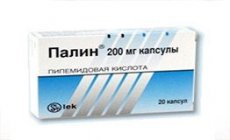Medical expert of the article
New publications
Preparations
Palin
Last reviewed: 23.04.2024

All iLive content is medically reviewed or fact checked to ensure as much factual accuracy as possible.
We have strict sourcing guidelines and only link to reputable media sites, academic research institutions and, whenever possible, medically peer reviewed studies. Note that the numbers in parentheses ([1], [2], etc.) are clickable links to these studies.
If you feel that any of our content is inaccurate, out-of-date, or otherwise questionable, please select it and press Ctrl + Enter.

Palin is part of the pharmacological group of antimicrobial agents - uroseptics, refers to first-generation quinolones, a derivative of naphthyridine. Other trade names for the drugs-synonyms: Pipemidin, Pipem, Pimadel, Pimidel, Pilamin, Pipelim, Urogenin, Uromidine, Uropimide, Septidron, and others.
Indications Palin
Palin is used in the treatment of acute and chronic inflammatory diseases of the urinary tract, such as cystitis, urethritis, urethral syndrome, chronic pyelonephritis, inflammation of the prostate gland (prostatitis).
Palin can be used to prevent infection when performing instrumental urological and gynecological examinations, when installing catheters after surgery, etc.
 [1]
[1]
Release form
Product: capsules of 0.2 g.
Pharmacodynamics
Pharmacological action Palin - bactericidal and bacteriostatic - provides the active substance pipemidovaya acid (in the form of pipemidin trihydrate). When contaminated tissue enters pipemidic acid due to condensed pyridine rings and the elimination of the nitrile group penetrates through the bacterial cell membrane and their enzyme complex is blocked.
The inhibition of enzymes that regulate the replication of pathogenic microorganisms leads to the impossibility of synthesizing RNA and transferring genetic information from the matrix of the parent DNA molecule of the bacterium. As a result, the process of dividing bacteria ceases and they die.
Palin is effective against Gram-negative bacteria Proteus mirabilis, Escherichia coli, Enterobacter cloacae, Serratia marcescensi, Haemophilus influenzae, Morganella morganii, Klebsiella sp., Citrobacter sp., Alcaligenes sp., Acinetobacter sp.
Bacteria Pseudomonas, Chlamydia, Mycobacterium, as well as Gram-positive bacteria are resistant to the action of this drug.
Pharmacokinetics
The palin is absorbed in the gastrointestinal tract and after 1-1,5 hours after administration reaches the maximum concentration in the body, and after 4-5 hours - in the urine. With proteins of blood plasma bind up to 30% of the active substance, the level of bioavailability of the drug does not exceed 60%.
The palin does not undergo transformation, up to 85% is excreted by the kidneys in unchanged form - with urine, the rest is excreted by the intestine.
Dosing and administration
The drug is taken orally, the tablets should be swallowed whole and washed down with a glass of water. Dosage and duration of treatment are determined by the attending physician. The standard dose is 0.4 g (two capsules) twice a day (with the same intervals of time between doses). Duration of application Palin - 10 days.
During treatment with this drug is recommended to increase the amount of fluid consumed.
Use Palin during pregnancy
Use Palin during pregnancy and during lactation is contraindicated.
Side effects Palin
The use of Palin can be accompanied by side effects in the form of decreased appetite, nausea, vomiting, diarrhea, constipation, abdominal pain, skin rashes, skin ultraviolet, articular and headaches, anemia, thrombocytopenia, tremors, sleep disturbances. Possible angioedema and anaphylactic shock.
Overdose
Palin causes a headache, dizziness, nausea and vomiting, tremors, convulsions. In case of an overdose, it is necessary to wash the stomach and take activated charcoal or another enterosorbent. If seizures occur, it is advisable to use anticonvulsants (diazepam).
Interactions with other drugs
The palin can not be combined with nitrofuran antibacterial agents (furazolidone, furazidine, nitrofuran, etc.); The use of a palin with other naphthyridine derivatives may increase the likelihood of seizures.
Antacids, preparations of bismuth, iron and zinc should be taken 4-6 hours before taking Palin, or 2 hours after taking it.
With the parallel intake of Palin and medicines such as cimetidine, warfarin and rifampicin, the effect of the latter on the body is intensified.
Storage conditions
Shelf life
Shelf life of the drug is 5 years.
Attention!
To simplify the perception of information, this instruction for use of the drug "Palin" translated and presented in a special form on the basis of the official instructions for medical use of the drug. Before use read the annotation that came directly to medicines.
Description provided for informational purposes and is not a guide to self-healing. The need for this drug, the purpose of the treatment regimen, methods and dose of the drug is determined solely by the attending physician. Self-medication is dangerous for your health.

